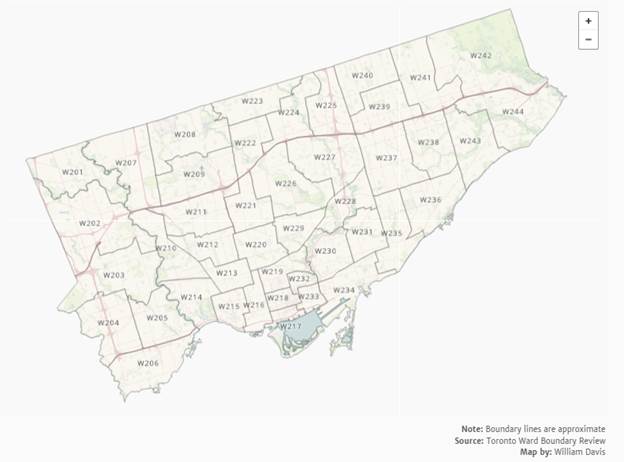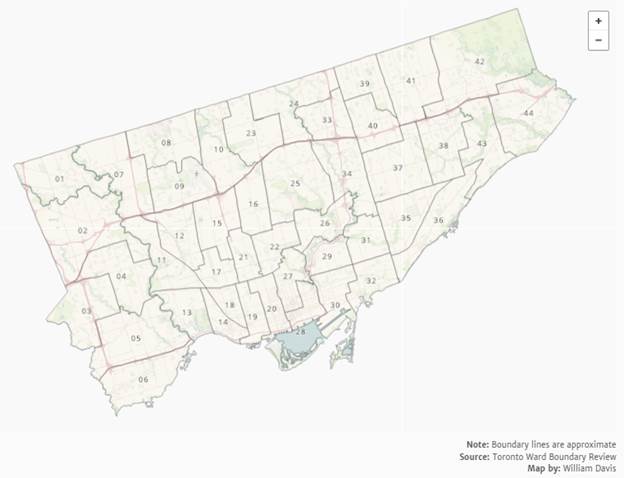
Battle brewing over Toronto ward boundaries
New lines on a map will shape Toronto's political future and could affect the urban-suburban power balance.
TheStar.com
Sept. 27, 2016
David Rider and Evelyn Kwong
Some residents of The Beach are aghast at the notion that a redrawing of Toronto’s political boundaries could suddenly thrust them into Scarborough.
“No one wants to live in Scarborough,” one woman grumbled in a Facebook thread about proposed changes that would, to equalize the population of Toronto’s 44 wards, carve up neighbourhoods including the proud waterfront community. About half of The Beach would join a new ward dominated by southwestern Scarborough.
Michael Thompson, who has represented Ward 37 Scarborough Centre for 15 years, chooses his words carefully when asked to respond to such fears. “I think Scarborough is the best place in the world to live, work and play, and I would invite people who don’t want to live here to come on a tour with me.”
The ongoing boundary review was launched in 2013 amid concerns that ward population disparities — some have almost 100,000 residents, others barely half that — mean Torontonians have unequal political representation.
It has triggered fierce debate at city hall, even though many Torontonians don’t actually know which ward is theirs. The final choice could shape the city’s politics and, to a small degree, loosen suburban councillors’ dominance on decision-making.
Joanne Purdon, author of the Facebook comment decrying the prospect of joining Scarborough, told the Star she fears that the new boundaries will “take away from the village within the city feel” that The Beach is known for. Via email, she said she hung out in the area in her youth, when “it was such a quaint area (with) lots of small unique businesses and no one wants to lose it to Scarborough.”
Mayor John Tory is adamant that Toronto doesn’t need more municipal politicians so the number of wards should be capped at the current 44. A report pegs the cost of any new ward at about $290,000 per year, plus one-time $70,000 start-up costs.
Thompson agrees with Tory, saying few Torontonians are asking for bigger government.
But many of his colleagues are rebelling against the option that would largely erase ward boundaries reflecting the former municipalities. Support is growing for a 47-ward option that keeps more areas intact.
“There is a gathering storm over the proposals that would redraw the map with 44 wards and carve up neighbourhoods,” said Councillor James Pasternak whose Ward 10 York Centre, stretching from Highway 401 to Steeles Ave. roughly between Bathurst and Dufferin Sts., would vanish entirely under that scenario.
“My ward is completely unique,” with Jewish and Italian neighbourhoods full of newcomers, he said. “To just erase the ward as if it there’s no history and meaning there is terribly misguided.”
“’Ward boundary review’ sounds so boring, people aren’t paying attention,” said Ward 32 Beaches-East York Councillor Mary-Margaret McMahon. “Maybe we should have called it ‘Losing your ward, losing your Beach, losing your councillor’ review.”
The rejigged 44-ward proposal “is not really registering but when Beachers find out about it, they’ll lose their minds,” predicted McMahon, who is not planning to run for re-election. She said she is hearing concerns about the possible dissection of a treasured neighbourhood, not about joining Scarborough which ceased to be a municipality when Toronto amalgamated in 1998.
Some councillors are worried that Toronto won’t get new boundaries set in time to use for the 2018 municipal election, raising the possibility of city wards being set at the province’s Ontario Municipal Board.
The city-hired consultant concluded 47 wards achieves the best voter parity with about 61,000 per ward. It would create three new downtown wards and one in North York, collapse three wards west of downtown into two, and redraw the boundaries of all but six wards.
At Tory’s urging, council voted to seek public consultation on two options, the one with 44 wards averaging 70,000 residents and another with 26 averaging 112,500 residents. The results will go to Tory’s executive committee next month, but full council will later be able to consider all options.
Tory’s staff said in an email his position is unchanged. The issue “is expected to come before executive committee later this year and the mayor will review and discuss with his council colleagues at that time.”
Councillor Ana Bailao (Ward 18, Davenport) said council needs to adopt preferred boundaries as soon as possible to allow time for a process that includes public consultation and an Ontario Municipal Board hearing.
“If we don’t do it well and thoughtfully and in a timely manner there is always the risk of the OMB deciding for us,” she said. “There’s lots of councillors feeling the same way as me, that we need more than 44 wards and residents need to be properly represented.”
Residents, Bailao said, usually agree with her when she points out they need a lot more contact with their councillor, and city hall, than with Toronto’s 25 members of parliament. “There’s an ‘Aha’ moment when people say ‘I want to be able to have that proximity to the things that affect me most.’ ”
Proposed Ward Boundaries

Current Ward Boundaries

